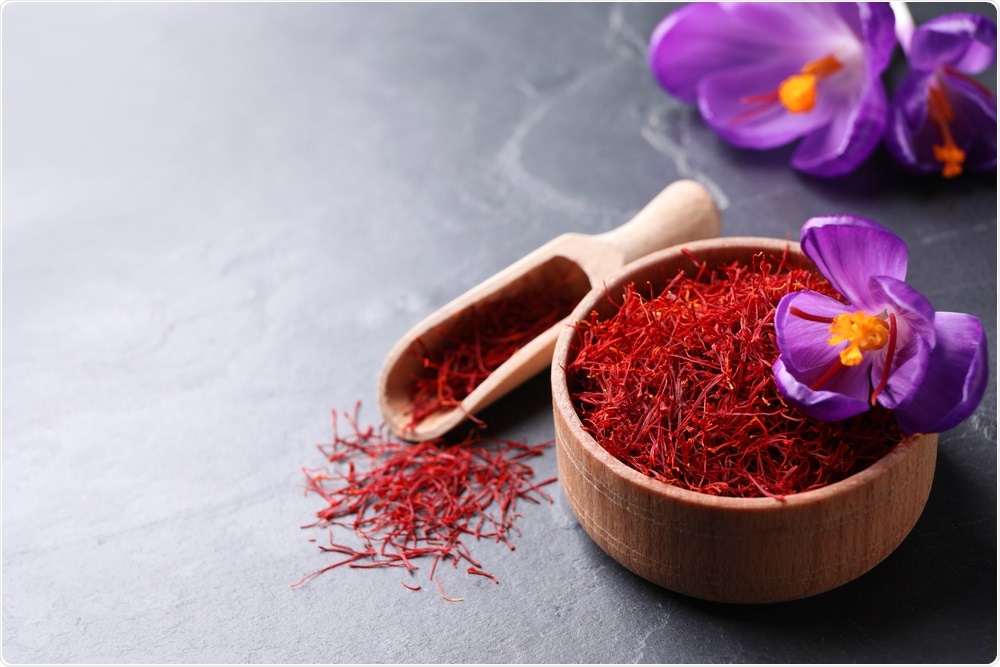Saffron is the costliest spice in the world and is extracted from the flowers of saffron crocus—Crocus sativus. For thousands of years, it has been cultivated in the Mediterranean region. However, the question “when and where was saffron first grown by the ancestors” remains. To answer that question, researchers conclude that the proofs from ancient art and genetics meet in the same region. The line of evidence was discussed as a review in Frontiers in Plant Science.

Image Credit: New Africa/Shutterstock.com
Both ancient artworks and genetics point to Bronze Age Greece, in approximately 1700 BCE or earlier, as the origin of saffron’s domestication.”
Ludwig Mann, PhD Student, Technische Universität Dresden
Mann is also one of the leading authors of this study.
With approximately 250 species, the genus Crocus can be found from South and Central Europe and North Africa to Western China. On contrary to the domesticated saffron, these species sexually reproduce in the wild.
Around 50000 years ago in present day Iraq, the wild crocuses were first used by humans as pigments for cave paintings. The usage of wild crocuses in dye and medicine was also described in ancient texts from Assyria, Sumer, and Babylonia.
On contrary, domesticated saffron does not grow in the wild, whereas it can only be asexually propagated with the help of humans. The process involves dividing its underground “corms,” which are stem-like storage organs. In the fourth to third century BCE, this process was first explained by Theophrastus—a Greek philosopher.
Currently, domesticated saffron is cultivated across the world, in cooking, perfumes, and as a yellow dye. Around 15000 to 16000 flowers, which need around 370–470 person/hour to gather, produce a single kilo that is worth $1300 to $10000.
Finding out where and when saffron was first domesticated isn’t straightforward: the species is difficult to study genetically, because it has three copies of every chromosome instead of the usual two, and a large genome containing a high percentage of difficult-to-sequence repetitive DNA.”
Seyyedeh-Sanam Kazemi-Shahandashti, Study Lead Author and PhD Student, Institute of Bio- and Geosciences
“As there are no ancient crocus remains preserved from ancient times, we here revisit ancient artworks that depict saffron-like plants. We expected that these could point us to specific regions,” added Seyyedeh-Sanam Kazemi-Shahandashti.
The authors debate that artworks of ancient Greece from the Minoan civilization are possibly the first to illustrate domesticated saffron. For instance, the fresco “The Saffron Gatherers” from the island of Santorini (around 1600 BCE) suggests cultivation through the dense patches of crocus flowers. “The Adorants”—another fresco on the same island—depicts flowers with long, dark-red stigmas that are overtopped with dark violet petals, which is typical of domesticated saffron.
Flowers with these features are also illustrated on cloth and ceramics from Bronze Age Greece, and they are symbolically mentioned in the ideogram for saffron in the prehistoric Linear B script. Egyptian tombs dating back to the 15th and 14th centuries BCE illustrate how ambassadors from Crete have taken tribute in the form of saffron-dyed textiles.
The findings from genetic studies from 2019 are agreed with an origin in Bronze Age Greece, which presented that C. cartwrightianus, occurring in mainland Greece and Crete, is saffron’s nearest wild relative.
The authors think that the modern saffron crocus, along with its three genomes originate from the wild naturally, either wholly from C. cartwrightianus or from hybrids between C. cartwrightianus and another crocus species. Because of saffron’s exceptional qualities as a spic, the crocus would have been retained by the Bronze Age Greeks.
Around the globe today, all saffron crocuses are effectively clones dating back to saffron’s emergence in ancient Greece. Nevertheless, despite sharing the same genome, saffron can have different properties depending on the region. We have started to investigate the molecular causes, in particular so-called ‘epigenetic’ differences, for this regional variation.”
Dr Tony Heitkam, Study Final Author and Leader, Plant Genomics Group, Technische Universität Dresden
Dr Heitkam concluded that authors will continue to trace the properties of saffron.
Source:
Journal reference:
Kazemi-Shahandashti, S. S., et al. (2022) Ancient Artworks and Crocus Genetics Both Support Saffron’s Origin in Early Greece. Frontiers in Plant Science. doi.org/10.3389/fpls.2022.834416.